Maneki-neko
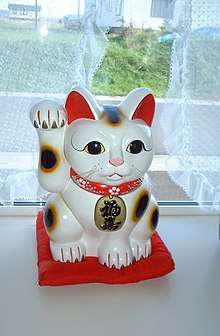
The maneki-neko (Japanese: 招き猫, literally "beckoning cat") is a common Japanese figurine (lucky charm, talisman) which is often believed to bring good luck to the owner. In modern times, they are usually made of ceramic or plastic. The figurine depicts a cat (traditionally a calico Japanese Bobtail) beckoning with an upright paw, and is usually displayed in—often at the entrance of—shops, restaurants, pachinko parlors, and other businesses. Some of the sculptures are electric or battery-powered and have a slow-moving paw beckoning.
Maneki-neko comes in different colors, styles and degrees of ornateness. Common colors are white, black, gold and sometimes red. In addition to ceramic figurines, maneki-neko can be found as keychains, piggy banks, air fresheners, house-plant pots, and miscellaneous ornaments, as well as large statues. It is also sometimes incorrectly called the "Chinese lucky cat" because of its popularity among Chinese merchants.

Common features
Gesture
To some Westerners (Italians and Spaniards are notable exceptions) it may seem as if the maneki-neko is waving rather than beckoning.[1][2] This is due to the difference in gestures and body language recognized by some Westerners and the Japanese. The Japanese beckoning gesture is made by holding up the hand, palm down, and repeatedly folding the fingers down and back, thus the cat's appearance. Some maneki-neko made specifically for some Western markets will have the cat's paw facing upwards, in a beckoning gesture that is more familiar to most Westerners.[3]
Maneki-neko can be found with either the right or left paw raised (and sometimes both). The significance of the right and left raised paw differs with time and place.[4] According to a general rule of thumb, statue with the left paw raised is meant to be displayed in drinking establishments, while the one with the right paw for all other places of business; another interpretation is that right is for home and left for business.[4]
Some maneki-neko feature battery- or solar-powered moving arms endlessly engaged in the beckoning gesture.
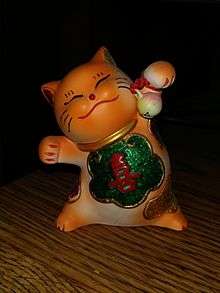
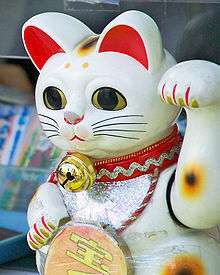
Composition
Antique examples of maneki-neko may be made of carved wood, stone and metal, handmade porcelain or cast iron.[4]
Origins
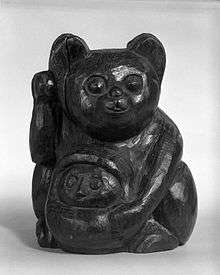
History
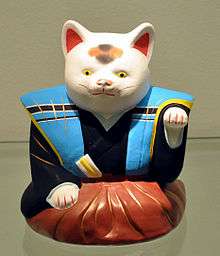
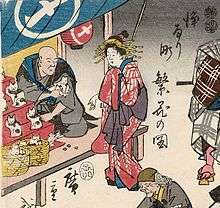
It is commonly believed that Maneki-neko originated in Tokyo (then named Edo), while some insist it was Kyoto.[4] Maneki-neko first appeared during the later part of the Edo period in Japan.[4] The earliest records of Maneki-neko appear in the Bukō nenpyō's (a chronology of Edo) entry dated 1852. Utagawa Hiroshige's ukiyo-e "Joruri-machi Hanka no zu," painted also in 1852, depicts the Marushime-neko, a variation of Maneki-neko, being sold at Senso temple, Tokyo. In 1876, during the Meiji era, it was mentioned in a newspaper article, and there is evidence that kimono-clad maneki-neko were distributed at a shrine in Osaka during this time. A 1902 advertisement for maneki-neko indicates that by the turn of the century they were popular.[5]
Beyond this the exact origins of maneki-neko are uncertain, though several folktales offer explanations.
Others have noted the similarities between the maneki-neko's gesture and that of a cat washing its face. There is a Japanese belief that a cat washing its face means a visitor will soon arrive. This belief may in turn be related to an even older Chinese proverb that states that if a cat washes its face, it will rain. Thus, it is possible a belief arose that a figure of a cat washing its face would bring in customers. In his Miscellaneous Morsels from Youyang, China's Tang Dynasty author Duan Chengshi (803?-863) wrote: "If a cat raises its paw over the ears and washes its face, then patrons will come".
Folktales
Maneki-neko is the subject of a number of folktales. Here are some of the most popular, explaining the cat's origins:
The stray cat and the shop: The operator of an impoverished shop (or inn, tavern, temple, etc.) takes in a starving, stray cat despite barely having enough to feed himself. In gratitude, the cat sits in the front of the store beckoning customers, thus bringing prosperity as a reward to the charitable proprietor. Ever after, the "beckoning cat" has been a symbol of good luck for small business owners.[4]
In popular culture
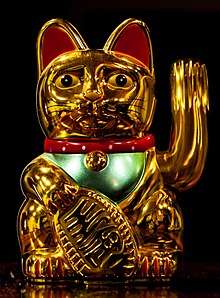
Modern Japanese folklore suggests that keeping a talisman of good fortune, such as the maneki-neko, in bedrooms and places of study will bring about favorable results and life successes.
Because of its popularity in Chinese communities (including Chinatowns in the United States)[4] the maneki-neko is frequently mistaken for being Chinese in origin rather than Japanese, and is incorrectly referred to as a "Chinese lucky cat" [4] or jīnmāo ("golden cat"). This cat is also prevalent in China domestically, and is usually referred to as the followings: simplified Chinese: 招财猫; traditional Chinese: 招財貓; pinyin: zhāocáimāo.
The Pokémon named Meowth is based upon the maneki-neko.[6] Unlike traditional Maneki-neko who hold the Koban coin, Meowth has the coin projected from its forehead. Meowth can fire this coin as a projectile weapon with its signature move Payday.
Netta performed her song "Toy" in front of two walls full of maneki-neko at the Eurovision Song Contest 2018. She won the competition after collecting 529 points at the final.[7]
See also
Notes
- ↑ Henry H. Calero (2005). The Power of Nonverbal Communication: How You Act is More Important Than what You Say. Silver Lake Publishing. p. 116. ISBN 978-1-56343-788-5.
- ↑ E. S. Wibbeke. "Gestures around the World". Globalbusinessleadership.com. Retrieved 4 December 2012.
- ↑ Shizuko Mishima. "Manekineko: Japanese Lucky Cats". Japan Travel. About.com. Archived from the original on 19 May 2012. Retrieved 3 August 2009.
- 1 2 3 4 5 6 7 8 Alan Pate (2008). "Maneki Neko: Feline Fact & Fiction". Daruma Magazine. Amagasaki, Japan: Takeguchi Momoko. Archived from the original on 30 December 2012. Retrieved 30 December 2012.
- ↑ Mark Schumacher. "Maneki Neko: The Lucky Beckoning Cat". A to Z Photo Dictionary of Japanese Buddhist Statuary. Retrieved 3 August 2009.
- ↑ http://bulbanews.bulbagarden.net/wiki/On_the_Origin_of_Species:_Meowth
- ↑ -, -. "Eurovision Song Contest 2018". Eurovision Song Contest. -. Retrieved 21 June 2018.
References
| Wikimedia Commons has media related to Maneki neko. |
- Dale-Green, Patricia, The Cult of the Cat (Houghton Mifflin, Boston, 1963). ISBN 978-0517175002
- Daniels, Inge Maria, 2003. Scooping, raking, beckoning luck: luck, agency and the interdependence of people and things in Japan. Royal Anthropological Institute 9 (4), 619–638. doi: 10.1111/j.1467-9655.2003.00166.x
- Masuda, Koh, Kenkyusha's New Japanese-English Dictionary (Kenkyusha Limited, Tokyo, 1991).
- Wellman, Laurel, Lucky Cat: He Brings You Good Luck (Chronicle Books, San Francisco, 2004). ISBN 0-8118-4121-9.